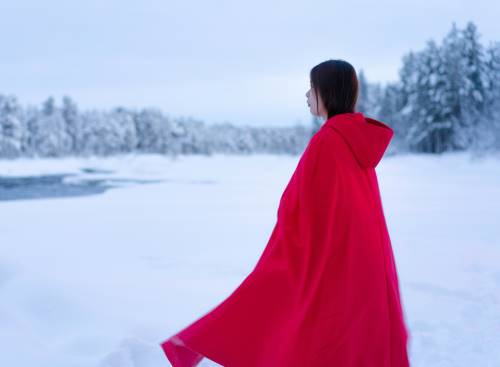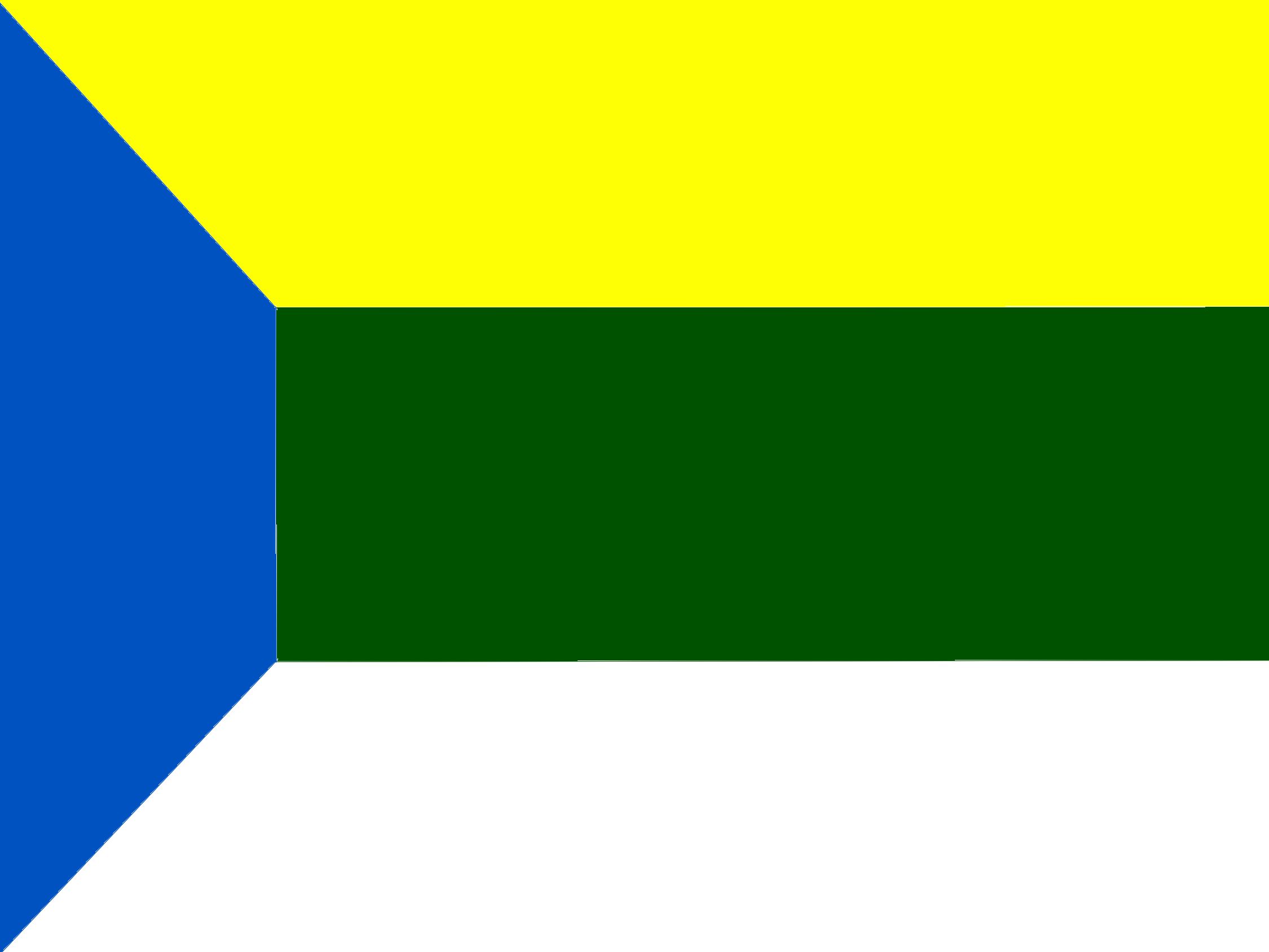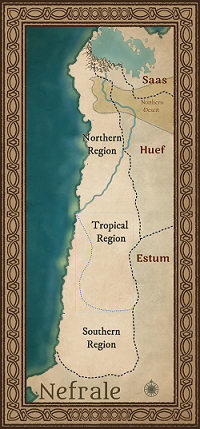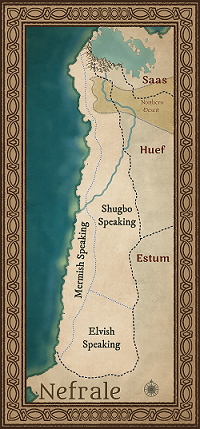Nefrale
From Whence the Phoenixes Arise
Each historical fiction project we have set out to write has been more daunting than the last: from researching Liri's great builder, Raveen, to establishing over a thousand years of history with the Staffs of Airrin Underwood. And yet, writing a story centered in Nefrale has been our greatest challenge yet. From its early days as one of Nideon's first settlements to its place on today's global stage, Nefrale has played an important role in so many of Nideon's greatest historical events. It is too significant to easily select one era to write within, and yet to write the history of the entire nation is to write a saga. And so, going back to Nefrale's earliest myths, we chose to tell the story of a phoenix, and his journey through one of Nideon's greatest countries.
--Preface to Flying Up the Coast
Of all of the countries on the west coast of the Major Continent, Nefrale has the longest coastline. It is known for its diverse population, as well as its long history and the home of Nideon's Phoenix legends.
History
Nefrale is one of the sites with the oldest artifacts in all of Nideon. Evidence of humans traces back several thousand years, though there is little evidence of other races tracing back so far. Nefrale is also the origin of the myths of phoenixes, and more people in Nefrale believe them than in other countries. In its early years, Nefrale had extensive conflicts with Linakra , on the other side of the major continent. This conflict primarily grew out of the use of magic. Linakra has always had an anti-magic stance, whereas Nefrale not only promoted the use of magic, the king encouraged the study of magic, so that people could better understand it and how to use it to their benefit. One notable event very early in Nefrale's history was in year 212, when the king declared that all "magically changed humans" were equal in the eyes of the law in Nefrale. This wording references the commonly held belief that the non-human races were once human, and changed into different forms by way of magic. The wording also implies that people may have been changed in more than one way, therefore some argue that this is evidence of phoenixes having existed. It is unlikely the Nefralean king would have run into dragons, elves, or sprites this early in the planet's history, but if he had only intended the law to stand for the Mermish, why would he not have been more specific? Others claim that the king was merely forward thinking, and understood that if there were Mermish, there could easily be other non-human peoples.Regions
Nefrale is divided by both geographic and linguistic grounds. Geographically, it is divided into three regions, with each area dominated by different racial groups. The Northern Region, which spans from Nefrale's northern border to the bank of the Rippling River, is home primarily to humans and mermaids. The Southern Region spans the coastline from the southern bank of the river as well as the most southern past of Nefrale, and is home to a mix of mermaids and elves. The Tropical Region, which lies between the two, is home almost exclusively to sprites.The country is also divided, however, into three linguistic regions: Shugbo, Elvish, and Mermish . These two divisions overlap, but do not follow the exact same borders. The Mermish region lies along Nefrale's coastline starting just south of the Overhanging Hills, the Shugbo region encompasses the non-coastal areas in the Northern and Tropical Regions, and the Elvish region is the non-coastal area of Nefrale's Southern Region. Within the Shugbo region is the Northern Desert, where the Huxoth people live, and Huxoth is the primary language in this area.
Population
Nefrale is very diverse. About 90% of the people who live there have citizenship, but this includes humans, elves, Sprites, Mermish, and even some of Dragons. There is also a small contingent of Pelan living in the country, as well as a group of Huxoth in the northern spit of desert. About 6% of the people who are not citizens are there as part of larger ethnic and racial groups that are welcome in Nefrale, such as Pelan refugees, sprite refugees, and the Huxoth.Religion
Nefrale is as religiously diverse as it is ethnically diverse, with its religious boundaries often aligning along cultural ones. Mun is the dominant religion along the coast and in northern Nefrale, except for the desert area, where the Huxoth people live. The Tropical Region is heavily Calistian, due to the number of sprites who live there, and even those who also follow other faiths usually mesh the two. Most of the elves in the Southern Region follow the Vitnu faith, while the humans tend toward the Een religion, with more people following the Viraronan branch of the faith than the Diamondheart branch. There is also a small group of Thisaazhou living in southern Nefrale however, and one can see many Shax'ia shrines along the roads there. Nefrale is also the country with the largest population that openly identifies as atheist, likely due to the rise in popularity of Astromythology .Government
The Nefralean King serves as both the head of state and the head of government. The king works in tandem with and leads the legislative body, which consists of 790 elected positions. Elections for members are held every six years, with half of the members running, and the other half running the next six years. The king also works closely with the Council of Races, an advisory body of twenty officials who are chosen by the legislature every three years. Ten of the seats on the council are "permanent," meaning they are always held by a member of them same group--two seats each to sprites, elves, mermaids, wizards, and non-magical humans. The other ten seats are "temporary," and rotate between different groups the Nefralean legislature believes should be represented. During the majority of its existence, 2 of these seats have been held by dragons and 2 by members of the Huxoth tribe. Members of the Council of Races cannot vote, but may otherwise participate in legislative meetings. They also meet separately with the king. Regional governments are formed along both cultural and linguistic divisions, with different governments being in charge of different aspects of government. For example, the linguistic regional governments are in charge of schools while the geographic regional governments are in charge of housing and transportation.Military
Nefrale has 40,000-50,000 active troops in their military force. This is divided into three groups--army, navy, and medical.Education
Education is compulsory from age 6 to age 18. Though nearly 100% of the adult population is technically literate, many of them do not read well. Furthermore, education in northern Nefrale remains stronger than in southern Nefrale. Most schools are secular, and run entirely by the government, but some communities have religious schools which are organized by religious groups and subsidized by local governments. Though the linguistic regional governments are in charge of education, the requirements that schools must meet, such as curriculum requirements and compulsory education, is determined by the national legislature.

by Snowy Vin
The Phoenix Legend
Though astromythology is not a commonly held belief, most people on Nideon do believe that the non-human races were once human, but changed irrevocably by magic. This is why they still bear a human appearance and speak in human tongues. While sprites, elves, mermaids, and dragons are well known throughout the world, legends originating in Nefrale speak of other non-human races. The most famous of these is the Phoenix, which has become a national symbol for Nefrale.
According to the legend, phoenixes are two-form beings who were changed by fire magic. They look human, but can transform at will into eagle-like birds. Not only can they manipulate fire, but they can use it to heal themselves and others. Phoenix fire is said to be so powerful that phoenixes can use it to regenerate, reversing their age and effectively allowing themselves to be reborn. While most people believe the phoenix is just a legend, some do believe in their existence and try to track them down for their healing fire and beautiful feathers.
Regional Variation
While the general myth remains the same, there are variations within it. In northern Nefrale, particularly near the Overhanging Hills and in the desert area, the story says that the people do not manipulate fire, but electricity. These versions usually depict a Phoenix's bird form as being white and yellow rather than red and yellow. They are sometimes called jigiyogi, or lightning birds. This version of legend was famously used in Sarah Xyn's famous novel Zoey Coral and the Eagle of Lightning. A less common variation on the myth says that the birds are blue and white, as is a phoenix's fire because it burns so hot.Magicali
Another legend in Nefrale says that people were once so affected by magic that they were made almost immortal. These people are known as Magicali, and they are said to age to young adulthood, and then live for hundreds of years before growing old. Like the phoenix legend, variations on this myth speak of the magicali being affected by different types of magic. But the myth of the magicali never caught fire the way the phoenix legend did.Industry and Trade
Along with Saas, Nefrale was one of the first nations on the Major Continent to industrialize. Southern Nefrale developed a textile industry, though it suffered a crisis in the mid-19th century. Since that time research and development of medicines has become prominent in Nefrale, though this is bigger in northern Nefrale, which is economically more stable than the south. The coastline remains a common place for fishing, and Nefrale often exports fish to its eastern neighbors.Transportation
Nefrale is famous for its network of trains that run throughout the country. Trains are such a popular form of transportation that roads between large cities usually lack upkeep more than those between small towns, and people in Nefrale prefer to travel by train when possible. Furthermore, many people do not own personal vehicles. Some of the trains even connect to Nefrale's eastern neighbors and serve as the main transport for trade goods. The country also has four transport stations.
The First, The Last, The Eternal
Type
Geopolitical, Country
Demonym
Nefralean
Leader
Government System
Monarchy, Constitutional
Power Structure
Autonomous area
Currency
Kraech
Major Exports
fish, medicines
Major Imports
raw materials, chemicals, foodstuffs
Location
Controlled Territories
Neighboring Nations
Notable Members
Related Myths

by Molly Mar
Nefralean Linguistic Regions





Comments